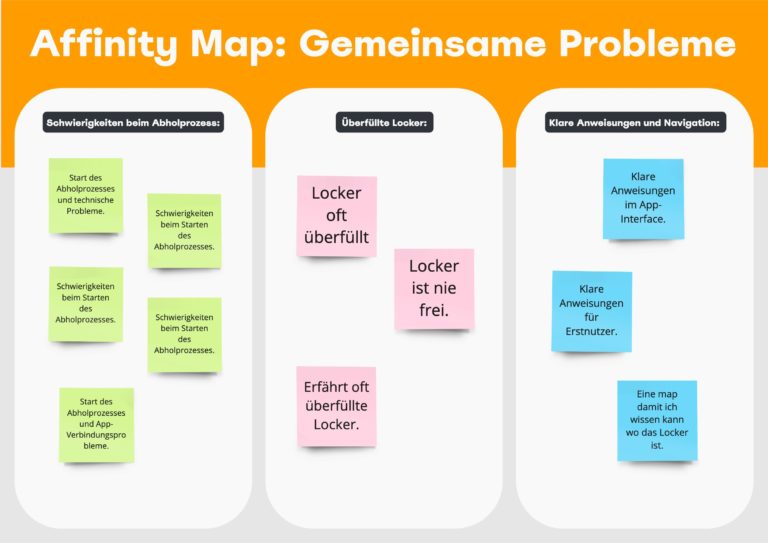Amazon Locker User Experience Optimization
Project Overview
This fictitious case study demonstrates how I applied Design Thinking to analyze and optimize the user experience of Amazon Lockers, particularly the screenless variant that uses Bluetooth technology. While the project visuals remain in German due to the original project language, the methodology and insights are universally applicable.
1. Problem Definition and Research
To identify and deeply understand the challenges users faced, I conducted:
-
Comprehensive Research:
I reviewed forums, user reviews, and articles to gather quantitative and qualitative insights into the Amazon Locker experience. -
User Interviews and Persona Development:
The study incorporated the development of detailed user personas based on interviews with individuals from diverse demographic and professional backgrounds. These personas provided valuable insights into user behaviors, frustrations, and goals, helping to identify key pain points and guiding the creation of innovative, user-centered solutions.
Key Findings from Personas:
- Technical Issues: Bluetooth connection failures during the pick-up process.
- Confusing Navigation: Difficulty locating lockers and using app features.
- Overcrowded Lockers: Stress and frustration caused by unavailable locker space.
Tools Used:
To structure and analyze user feedback, I created Affinity Maps and Empathy Maps, grouping recurring themes and behaviors to reveal the most pressing challenges.
2. Framing the Challenge with “How Might We” Statements
Based on the research, I transformed insights into actionable “How Might We” statements, which served as a foundation for ideation:
- HMW 1: How might we simplify the package pick-up process through intuitive app features?
- HMW 2: How might we ensure a seamless connection between the app and lockers?
- HMW 3: How might we make app navigation clearer and more accessible for all users?
These questions enabled a focused, user-centric approach to brainstorming and solution development.
3. Ideation and Solution Development
Generating Ideas:
I organized a structured brainstorming session to generate innovative solutions, resulting in several key ideas:
- Automatic Bluetooth Connection: Seamless locker connectivity when users approach.
- Intuitive Unlock Button: Replacing the “Connect” button with a clearly labeled “Unlock” button for ease of use.
- Real-Time Notifications: Updates on locker availability to prevent overcrowding and improve accessibility.
Prioritization:
Each idea was evaluated for feasibility and user impact, with the most promising solutions selected for prototyping.
4. Prototyping
Low-Fidelity Prototype:
I created simple wireframes to visualize the selected solutions and facilitate rapid iteration based on peer feedback.
High-Fidelity Prototype:
Using tools like Figma, I designed an interactive prototype that integrated:
- A prominent “Unlock” button for streamlined access.
- Enhanced navigation tools for easier locker location.
- Push notifications to guide users through the pick-up process intuitively.
5. Usability Testing
Testing Methodology:
To validate the prototype, I conducted usability tests where participants were given a scenario: “Retrieve a package from an Amazon Locker.” Feedback focused on:
- Process clarity.
- Technical functionality.
- Visual intuitiveness.
Test Results:
- Strengths: Users found the navigation and “Unlock” button significantly more intuitive.
- Improvements Needed: Some users suggested repositioning the “Turn on Bluetooth” button for better visibility.
6. Results and Recommendations
Implemented Improvements:
- Button Repositioning: Moved the “Turn on Bluetooth” button to the map view for immediate access.
- Renaming: Updated the “Connect” button to “Unlock” for better clarity.
- Simplified Notifications: Reduced the steps needed to access package details, improving efficiency.
Impact:
- Navigation steps were reduced by 50%, streamlining the user journey.
- User satisfaction improved significantly, with a post-test feedback score of 8/10.
7. Conclusion
This case study demonstrates my ability to:
- Analyze diverse user needs: Through structured research and persona development.
- Develop and refine solutions: Using iterative prototyping and user feedback.
- Deliver measurable improvements: Enhancing usability and satisfaction through targeted adjustments.
What Makes This Project Unique?
This project highlights my capability to approach complex user challenges with a methodical and creative mindset. By combining user insights with technical expertise, I delivered a user-centric solution that reflects real-world applicability.
Although fictitious, the study serves as a testament to my skills in Design Thinking, problem-solving, and user experience design, making me a valuable asset to any innovative team.








